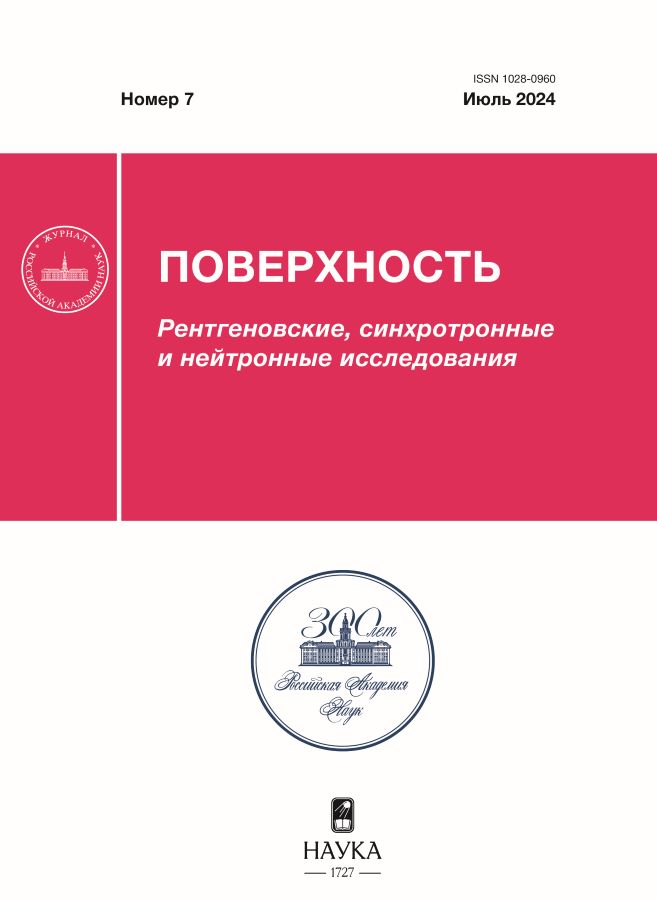Synthesis of thin films of magnesium aluminate spinel by Al and Mg anodic evaporation
- Authors: Gavrilov N.V.1,2, Emlin D.R.1, Medvedev А.I.2, Skorynina P.А.3
-
Affiliations:
- Institute of Electrophysics of the Ural Branch of the Russian Academy of Sciences
- Ural Federal University named after the first President of Russia B.N. Yeltsin
- Institute of Engineering Science of the Ural Branch of the Russian Academy of Sciences
- Issue: No 7 (2024)
- Pages: 9-18
- Section: Articles
- URL: https://freezetech.ru/1028-0960/article/view/664788
- DOI: https://doi.org/10.31857/S1028096024070022
- EDN: https://elibrary.ru/EVQHER
- ID: 664788
Cite item
Abstract
The structure and properties of alumomagnesium spinel films synthesized by reactive anodic evaporation of Al and Mg from individual crucibles in a low–pressure arc (Ar/O2 mixture at 0.7–1.2 Pa) and vapor condensation on a substrate at 400–600°C were investigated. The current of a discharge with a self–heated hollow cathode was distributed between the anode (10–30 A) and crucibles with Mg (0.8–1.6 A) and Al (4–16 A), which provided an independent change in the deposition rate of films, plasma density, partial pressures of metal vapors and concentrations of elements in the films. A decrease in the rate of Mg oxidation and stabilization of the evaporation process were achieved by increasing the power density of the electron flux on the Mg inside the crucible and transition from the evaporation by sublimation to the evaporation from the liquid state by reducing the aperture of the Mg crucible. The high density of Mg vapor flow in a small aperture prevents oxygen from entering the crucible. The crystallization temperature of spinel under conditions of bombardment of the growing film by ions with an energy of 25–100 eV at a current density of 2 mA/cm2 was ~400°C. The films were characterized by scanning electron microscopy, X-ray phase analysis and microhardness measurements. Cubic spinel films had a strong texture (100) and a micro-distortion level of the crystal lattice of ~1%. The deposition rate of non-stoichiometric spinel films with a relative content of Al and Mg atoms adjustable within 1.2–2.4 was 1–3 µm/h.
Full Text
About the authors
N. V. Gavrilov
Institute of Electrophysics of the Ural Branch of the Russian Academy of Sciences; Ural Federal University named after the first President of Russia B.N. Yeltsin
Author for correspondence.
Email: gavrilov@iep.uran.ru
Russian Federation, Yekaterinburg; Yekaterinburg
D. R. Emlin
Institute of Electrophysics of the Ural Branch of the Russian Academy of Sciences
Email: erd@iep.uran.ru
Russian Federation, Yekaterinburg
А. I. Medvedev
Ural Federal University named after the first President of Russia B.N. Yeltsin
Email: gavrilov@iep.uran.ru
Russian Federation, Yekaterinburg
P. А. Skorynina
Institute of Engineering Science of the Ural Branch of the Russian Academy of Sciences
Email: gavrilov@iep.uran.ru
Russian Federation, Yekaterinburg
References
- Гаврилов Н.В., Каменецких А.С., Емлин Д.Р., Третников П.В., Чукин А.В. // Журнал технической физики. 2019. Т. 89. № 6. С. 867. https://www.doi.org/10.21883/JTF.2019.06.47632.214-18
- Каменецких А.С., Гаврилов Н.В., Третников П.В., Чукин А.В., Меньшаков А.И., Чолах С.О. // Известия Вузов. Физика. 2020. Т. 63. № 10. С. 144. https://www.doi.org/10.17223/00213411/63/10/144
- Ahmad S.M., Hussain T., Ahmad R., Siddiqui J., Ali D. // Mater. Res. Express. 2018. № 5. P. 016415. https://www.doi.org/10.1088/2053-1591/aaa828
- Ganesh I. // Int. Mater. Rev. 2013. V. 58. № 2. P. 63. https://www.doi.org/10.1179/1743280412Y.0000000001
- Zhang J., Stauf G.T., Gardiner R., Buskirk P.V., Steinbeck J. // J. Mater. Res. 1994. V. 9. № 6. P. 1333. https://www.doi.org/10.1557/JMR.1994.1333
- Putkonen M., Nieminen M., Niinisto L. // Thin Solid Films. 2004. V. 466. P. 103. https://www.doi.org/10.1016/j.tsf.2004.02.078
- Станчик А.В., Гременок В.Ф., Труханова Е.Л., Хорошко В.В., Сулейманов С.Х., Дыскин В.Г., Джанклич М.У., Кулагина Н.А., Амиров Ш.Е. // Computational Nanotechnology. 2022. V. 9. № 1. P. 125. https://www.doi.org/10.33693/2313-223X-2022-9-1-125-131
- Wang Y., Xie X., Zhu C. // ACS Omega. 2022. V. 7. P. 12617. https://www.doi.org/10.1021/acsomega.1c06583
- Saraiva M., Georgieva V., Mahieu S., van Aeken K., Bogaerts A., Depla D. // J. Appl. Phys. 2010. № 7. Р. 034902. https://www.doi.org/10.1063/1.3284949
- Honig R.E. // RCA Rev. 1957. V. 18. P. 195.
- Depla D., Mahieu S. Reactive sputter deposition. Springer Series in Materials Science. Berlin Heidelberg: Springer-Verlag, 2008. 584 р. https://www.doi.org/10.1007/978-3-540-76664-3
- Гаврилов Н.В., Каменецких А.С., Паранин С.Н., Спирин А.В., Чукин А.В. // Приборы и техника эксперимента. 2017. № 5. C. 136. https://www.doi.org/10.7868/S0032816217040152
- Eriksson K.B.S., Isberg H.B.S. // Ark. Fys. 1963. V. 23. Iss. 47. P. 527.
- Meißner K.W. // Ann. Phys. 1938. V. 423. P. 505.
- Зимон А.Д. Адгезия пленок и покрытий. Москва: Химия, 1977. 352 с.
- TOPAS V. 3.0 (2005) Brucker AXS GmbH, Karlsruhe. www. bruker-axs.de
- Domanski D., Urretavizcaya G., Castro F.J., Gennari F.C. // J. Am. Ceram. Soc. 2004. V. 87. № 11. P. 2020. https://www.doi.org/10.1111/j.1151-2916.2004.tb06354.x
- Georgieva V., Saraiva M., Jehanathan N., Lebelev O.I., Depla D., Bogaerts A. // J. Phys. D: Appl. Phys. 2009. V. 42. P. 065107. https://www.doi.org/10.1088/0022-3727/42/6/065107
- Henkelman G., Uberuaga B.P., Harris D.J., Harding J.H., Allan N.L. // Phys. Rev. B: Condens. Matter. 2005. V. 72. P. 115437. https://www.doi.org/10.1103/PhysRev B.72.115437
- Yusupov M., Saraiva M., Depla D., Bogaerts A. // New J. Phys. 2012. V. 14. P. 073043. https://www.doi.org/10.1088/1367-2630/14/7/073043.
- Dash S., Sahoo R.K., Das A., Bajpai S., Debasish D., Saroj K.S. // J. Alloys Compd. 2017. V. 726. P. 1186. https://www.doi.org/10.1016/j.jallcom.2017.08.085
- Shou-Yong J., Li-Bin L., Ning-Kang H., Jin Z., Yong L. // J. Mater. Sci. Lett. 2000. V. 19. P. 225. https://www.doi.org/10.1023/A:1006710808718
- Шеховцов В.В., Скрипникова Н.К., Улмасов А.Б. // Вестник ТГАСУ. 2022. Т. 24. № 3. C. 138. https://www.doi.org/10.31675/1607-1859-2022-24-3-138-146
- Murphy S.T., Gilbert C.A., Smith R., Mitchell T.E., Grimes R.W. // Philosophical Magazine. 2010. V. 90. № 10. Р. 1297. https://www.doi.org/10.1080/14786430903341402
Supplementary files

















